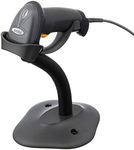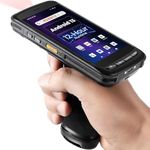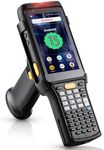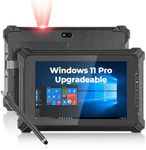Buying Guide for the Best Code Scanners
When choosing a code scanner, it's important to consider your specific needs and the environment in which you'll be using the scanner. Code scanners are used to read barcodes and QR codes, and they come in various types and with different features. Understanding the key specifications will help you select the best scanner for your requirements. Here are the main specs to consider and how to navigate them.Type of ScannerCode scanners come in different types, such as handheld, fixed-mount, and mobile. Handheld scanners are versatile and can be used in various settings, from retail to warehouses. Fixed-mount scanners are ideal for high-volume scanning in industrial environments. Mobile scanners are integrated into devices like smartphones and are great for on-the-go scanning. Choose the type based on where and how you plan to use the scanner.
ConnectivityConnectivity options include wired (USB, RS232) and wireless (Bluetooth, Wi-Fi). Wired scanners are reliable and don't require charging, making them suitable for stationary use. Wireless scanners offer more flexibility and mobility, which is useful in large areas or when you need to move around. Consider your work environment and whether you need the freedom to move without being tethered by a cable.
Scanning TechnologyThere are two main scanning technologies: laser and imaging (CCD or CMOS). Laser scanners are fast and accurate for reading 1D barcodes, making them ideal for retail and inventory management. Imaging scanners can read both 1D and 2D barcodes (like QR codes) and are better for applications requiring more data, such as in healthcare or logistics. Choose the technology based on the types of codes you need to scan.
DurabilityDurability is crucial if you plan to use the scanner in harsh environments. Look for scanners with rugged designs, high drop resistance, and IP ratings for dust and water resistance. For example, an IP54 rating means the scanner is protected against dust and splashes of water. If you work in a warehouse or industrial setting, a more durable scanner will ensure longevity and reduce downtime.
Scanning Speed and RangeScanning speed is measured in scans per second (SPS), and a higher SPS means faster scanning. Range refers to the distance from which the scanner can read a code. Short-range scanners are suitable for close-up scanning, while long-range scanners can read codes from several feet away. Consider the volume of scanning you need to do and the typical distance from which you'll be scanning codes to choose the right speed and range.
CompatibilityEnsure the scanner is compatible with your existing systems, such as point-of-sale (POS) systems, inventory management software, or mobile devices. Check for compatibility with operating systems like Windows, iOS, or Android. Compatibility ensures seamless integration and efficient workflow. If you have specific software or hardware requirements, make sure the scanner can work with them.
Ease of UseEase of use includes factors like ergonomics, weight, and user interface. A comfortable, lightweight scanner reduces fatigue during extended use. Intuitive interfaces and easy setup processes save time and reduce the learning curve. If multiple people will be using the scanner, choose one that is user-friendly and requires minimal training.






















